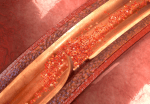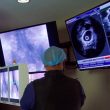In the era of endovascular intervention, with shorter revascularization times, we see lower rates of mechanical complications due to acute myocardial infarction (AMI). Increased rates were recorded during the COVID-19 pandemic, but driven by delays in consultation. Though occasional (with an estimated incidence of 0.2%), post AMI ventricular septal defect (VSD), or interventricular communication, involves...
Spontaneous Coronary Artery Dissection: Are There Differences Between Men and Women?
Spontaneous coronary artery dissection is one of the causes of acute coronary syndrome, with a prevalence between 1 and 4%, that might reach up to 35% in women <50 years old, according to recent studies. As dissections are more frequent in women, research focuses on this population. Small retrospective studies have shown different triggers and predisposing...
Early invasive Strategy for Non-ST Elevation ACS in Chronic Kidney Disease
Many randomized studies and systematic revisions have shown that an early invasive approach (within 24hrs. after diagnosis) will not reduce mortality across the non-ST elevation acute coronary syndrome (NST-ACS) population, hence the relevance of NST-ACS; patients with a GRACE score higher than 140 were the ones showing improved outcomes. Roughly 40% of NST-ACS patients have...
Spontaneous Coronary Artery Dissection: Treatment and Prognosis
Spontaneous coronary artery dissection (SCAD) is a non-traumatic nor iatrogenic event that causes a separation of the coronary artery tissue due to an intimal tear or a mural spontaneous hemorrhage. This event is most frequent in young females and usually causes an acute myocardial infarction that could be major. It accounts for 1% to 4%...
TCT 2022 | PCSK9 Inhibitor in Patients with STEMI to Lower LDL Cholesterol
In patients with ST-elevation myocardial infarction (STEMI), early treatment with statins —regardless of low-density lipoprotein (LDL) cholesterol levels — is routine around the world. Adding a potent LDL lowering agent, as a PCSK9 inhibitor, has proven clinical benefits in patients with a history of acute coronary syndrome or atherosclerosis, since treatment with statins have not...
TCT 2022 | Angioplasty vs. Surgery: The BEST Study Long-Term Results
The BEST study was a prospective, randomized study to compare percutaneous coronary intervention (PCI) with everolimus-eluting stents vs. myocardial revascularization surgery (MRS) in patients with multivessel disease. The analysis was interrupted early due to slow patient inclusion. The study included 880 patients, who were randomized 438 to the PCI arm and 442 to the MRS arm....
TCT 2022 | CLASP II D TRIAL: Transcatheter Edge-to-Edge Repair for Mitral Regurgitation in Patients at Prohibitive Risk
The CLASP IID study was a prospective randomized study to assess the efficacy and effectiveness of the PASCAL transcatheter valve repair system compared with the MitraClip device for patients with degenerative mitral regurgitation (MR) at prohibitive surgical risk. The study included Patients at prohibitive surgical risk, candidates for both devices, with MR 3+ to 4+,...
Mortality and Bleeding in Access Site Choice: Systematic Review
In 1992, Kiemeneij performed the first transradial coronary procedure, following Campeau’s description of that access in 1989. It’s been 30 years since that milestone in interventional cardiology. Over time, the number of procedures conducted with this approach has increased exponentially, and it is the main approach in most centers in different clinical scenarios. Historically, the...
Heparin Pretreatment in STEACS Treatment: A New Old Ally?
The treatment of ST-segment elevation acute coronary syndromes (STEACS) is undoubtedly reperfusion therapy with primary percutaneous coronary intervention. Similarly, nobody doubts that the pretreatment with more stronger antiplatelet agents has a role in such a treatment. In certain sites, unfractionated heparin (UFH) pretreatment is also administered before the patient enters the cath lab; its aim...
Are FFR and IVUS Similar to Assess Intermediate Lesions?
In coronary artery disease (CAD), lumen area and plaque burden, characteristics and physiological impact are what define prognosis. At present, coronary angiography continues to be the gold standard for CAD assessment. When considering PCI to treat intermediate lesions, FFR has been shown beneficial and safe. Not yet IVUS. 1682 patients with intermediate lesions (40 –...






